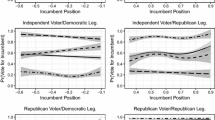Abstract
The traditional spatial model of elections places voters and candidates in an ideological space. Empirical analysis of spatial theory uses voter ratings of candidate and ideal positions on policy issue scales. The spatial model can be enhanced by the incorporation of nonpolicy components as well. These nonpolicy issues can be descriptive (age, ethnicity) or affective (honesty, competence). Using responses for a survey conducted during the 1965 Canadian federal election, an empirical evaluation of these nonpolicy issues is made. Voters are not unanimous in perceptions of parties (or candidates) on nonpolicy dimensions. The traditional spatial model can be extended to include individual voter ideal points and perceptions. This enhanced model proves quite successful at predicting vote choice.
Similar content being viewed by others
References
Aldrich, J. H. & McKelvey, R. D. (1977). A Method of Scaling with Applications to the 1968 and 1972 Presidential Elections.American Political Science Review 71: 111–130.
Blake, D. E. (1982). The Consistency of Inconsistency: Party Identification in Federal and Provincial Politics.Canadian Journal of Political Science 15: 691–710.
Clarke, H. D., Jenson, J., LeDuc, L., & Pammett, J. H. (1979).Political Choice in Canada. Toronto: McGraw-Hill Ryerson.
Cox, G. W. (1990). Multicandidate Spatial Competition. In James M. Enelow and Melvin J. Hinich, eds.,Advances in the Spatial Theory of Voting. Cambridge: Cambridge University Press.
Converse, P. E. (1966). The Problems of Party Distances in Models of Voting Change. In M. Kent Jennings and Harmon K. Ziegler, eds.,The Electoral Process. Englewood Cliffs: Prentice Hall.
Converse, P., Meisel, J., Pinard, M., Regenstrief, P., & Schwartz, M. (1966).1965 Canadian National Election Study [computer file]. Ann Arbor, MI: Inter-university Consortium for Political and Social Research [producer and distributor].
Davis, O. A. & Hinich, M. J. (1966). A Mathematical Model of Policy Formation in a Democratic Society. In J. L. Bernd, ed.,Mathematical Applications in Political Science II. Dallas: Southern Methodist University Press.
Davis, O. A., Hinich, M. J., & Ordeshook, P. C. (1970). An Expository Development of a Mathematical Model of the Political Process.American Political Science Review 64: 426–48.
Endersby, J. W. & Hinich, M. J. (1992). The Stability of Voter Perceptions: A Comparison of Candidate Voter Positions across Time Using the Spatial Theory of Voting.Mathematical and Computer Modelling 16: 67–84.
Enelow, J. M. (1988). A Methodology for Testing a New Spatial Model of Elections.Quality and Quantity 22: 347–364.
Enelow, J. M., Endersby, J. W. & Munger, M. C. (1993). In B. J. Grofman, ed.,Information, Participation and Choice. Ann Arbor: University of Michigan Press.
Enelow, J. W. & Hinich, M. J. (1982). Nonspatial Candidate Characteristics and Spatial Competition.Journal of Politics 44: 115–30.
Enelow, J. M. & Hinich, M. J. (1984).The Spatial Theory of Voting: An Introduction. Cambridge: Cambridge University Press.
Enelow, J. M. & Hinich, M. J. (1985). Estimating the Parameters of a Spatial Model of Elections: An Empirical Test Based on the 1980 National Election Study.Political Methodology 11: 249–268.
Enelow, J. M., Hinich, M. J. & Mendell, N. J. (1986). An Empirical Evaluation of Alternative Spatial Models of Elections.Journal of Politics 48: 675–693.
Englemann, F. C. & Schwartz, M. A. (1975).Canadian Political Parties. Scarborough, Ont.: Prentice-Hall.
Grofman, B. (1985). The Neglected Role of the Status Quo in Models of Issue Voting.Journal of Politics 47: 230–237.
Hinich, M. J. & Pollard, W. (1981). A New Approach to the Spatial Theory of Electoral Competition.American Journal of Political Science 25: 323–41.
Jenson, J. (1975). Party Loyalty in Canada: The Question of Identification.Canadian Journal of Political Science 8: 543–653.
LeDuc, L., Clarke, H. D., Jenson, J., & Pammett, J. H. (1984). Partisan Instability in Canada: Evidence from a New Panel Study.American Political Science Review 78: 470–484.
Lemieux, V. (1969). La Composition des préférences partisanes.Canadian Journal of Political Science 2: 397–418.
Meisel, J. (1972). Party Images in Canada: A Report on a Work in Progress.Working Papers in Canadian Politics Montreal: McGill-Queen's University Press.
Poole, K. T. & Rosenthal, H. (1984). U.S. Presidential Elections 1968–80: A Spatial Analysis.American Journal of Political Science 28(2): 282–312.
Rabinowitz, G. B. (1973)Spatial Models of Electoral Choice: An Empirical Analysis. Chapel Hill: Institute for Research in Social Science.
Rabinowitz, G. B. (1978). On the Nature of Political Issues: Insights from a Spatial Analysis.American Journal of Political Science 70: 804–809.
Rusk, J. G. & Weisberg, H. F. (1972). Perceptions of Presidential Candidates: A Midterm Report.Midwest Journal of Political Science 16: 388–410.
Schwartz, M. (1974). Canadian Voting Behavior. In R. Rose, ed.,Electoral Behavior: Comparative Handbook. New York: Free Press.
Schwartz, M. (1977).Politics and Territory. Montreal: McGill-Queen's University Press.
Sniderman, P. M., Forbes, H. D., & Melzer, I. (1974). Party Loyalty and Electoral Volatility: A Study of the Canadian Party System.Canadian Journal of Political Science 7: 268–88.
Stokes, D. E. (1963). Spatial Models of Spatial Competition.American Political Science Review 57: 368–377.
Thorburn, H. E. (1972).Party Politics in Canada. 3rd ed. Scarborough: Prentice-Hall.
Uslaner, E. M. (1990). Splitting Image: Partisan Affiliations in Canada's ‘Two Political Worlds’.American Journal of Political Science 34: 961–981.
Van Loon, R. (1970). Political Participation in Canada: The 1965 Election.Canadian Journalof Political Science 3: 376–399.
Weisberg, H. F. & Rusk, J. G. (1970). Dimensions of Candidate Evaluations.American Political Science Review 64: 1167–1185.
Author information
Authors and Affiliations
Rights and permissions
About this article
Cite this article
Endersby, J.W. Nonpolicy issues and the spatial theory of voting. Qual Quant 28, 251–265 (1994). https://doi.org/10.1007/BF01098943
Issue Date:
DOI: https://doi.org/10.1007/BF01098943




